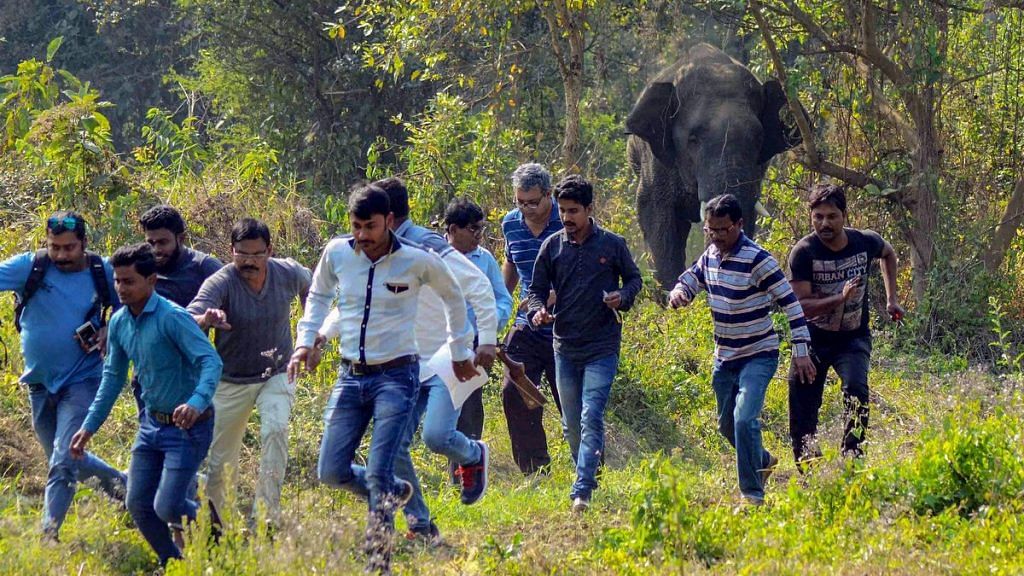The Indian Parliament was recently informed that 1,713 people and 373 elephants died in the last three years due to human-elephant conflicts across the country. In other words, three lives are lost every two days in India due to elephant attacks.
The figure will be even more staggering if we add other human-animal conflicts occurring frequently in remote corners of India. Not just lives, but properties worth lakhs are destroyed annually. It is equally disastrous for animals who are killed due to retribution, electrocution, habitat loss and road accidents. Such incidents are a big challenge to the Indian Forest Service (IFS) field officers and staff in crowd control as well as those managing wild animals in human habitations.
Increasing human-animal conflicts in India
Human-animal conflicts aren’t new. These intensified when large tracts of forest lands started getting cleared for agricultural purposes. Unplanned and unchecked exploitation of land and water place significant strain on the resources concurrently used by wild animals.
For example, heavy land encroachments and stone mining along the Tamil Nadu-Karnataka border led to the break up and shrinking of elephant habitat and the discontinuation of their crucial corridors. This increased the conflict between humans and elephants, as the animals had to now resort to other paths. Many land encroachers have also fenced their land, prompting elephants to use alternative routes, such as through farms. This causes the deaths of both farmers and elephants.
Mining in the traditional elephant habitat of Dalma Hills, Jharkhand, has forced the animals out of their territory and led to many deaths.
Also read: How an app is helping wild animals beat rash drivers
The value of forests
Land is prime and a scarce capital needed by an expanding human population and industries. Various government departments are also looking for land for developmental purposes. The forest department holds 22 per cent of the total land area in the country. From purely an economic point of view, this land has a very low contribution to the country’s GDP. But from an ecological point of view, this land provides fresh oxygen to an expanding population, purifies water consumed by the people and sequesters tonnes of carbon dioxide every year. Above all, these forest lands provide habitat to wild animals, which cannot be quantified.
Every hectare of forest lost puts increased pressure on these species by increasing their competition for food, water and habitat.
Forest corridors
Despite reports that India’s forest cover has increased to over 21 per cent from 14 per cent back in the 1950s, the reality is that wildlife habitats have been mosaiced and islands of forests have been created in the midst of agricultural and urban landscapes.
The islands do not offer connectivity to the animals living in these areas. Just like how roads connect cities, wildlife corridors are forest areas that connect two big forest landscapes. For instance, the Kanha-Pench Corridor in the Satpura Maikal landscape in Madhya Pradesh and Maharashtra is essential for tiger movement, and the Rajaji corridor in Uttarakhand that connects the western part of the state to the southeastern part is essential for elephant migration.
The issue is further complicated by climate change, which has increased the droughts and floods in the country. Many animals are forced to move far away in search of water because of the reducing number of rainy days in a season, which leads to drying up of small ponds and streams.
Also read: Electrocution, rail accidents, encroachment: Why elephants keep dying in India
Wildlife conservation
Wildlife conservation in independent India started in 1952 with the establishment of the Indian Board for Wildlife, and the landmark legislation –The Indian Wildlife (Protection) Act of 1972.
Through continuous targeted conservation efforts on a project basis – such as project tiger, project elephant, project hangul and so on – India has achieved considerable success in bringing back the population of many wild species from the brink of extinction. Tiger numbers have rebounded from a mere 268 in 1973 to over 2,200 in 2014. Elephant numbers have grown from 19,000 in 1985 to approximately 29,000 today. Rhino numbers have grown from 366 in 1970 to over 2,500 today in Kaziranga alone, which also houses the majority of the Rhino population in the country.
Just this week, a tiger was spotted in Gujarat, after nearly a three-decade wait. Forest officials camera-trapped the tiger in Mahisagar, a district adjoining Rajasthan – a clear sign that the big cat is reclaiming its old habitat.
Also read: India’s first & only elephant hospital is ‘illegal’, says Central Zoo Authority
Human-animal conflict should be reconfigured as interactions between humans and wild animals. The lens should not merely be on human needs, but also animal behaviour and requirements. A new dynamic wildlife management is needed instead of simple conservation. The latest National Wildlife Action Plan also adopts a ‘landscape approach’ in wildlife conservation.
It isn’t enough to just protect designated national parks and sanctuaries, we must safeguard wildlife corridors as well. When linear projects such as roads, railways, canals are taken up, the project proponent must provide for animal corridors (wildlife overbridges, underpasses, tree bridges or ropeways to facilitate arboreal species) at regular intervals all across the project length.
The authors are Indian Forest Service officers. Views expressed here are personal.
